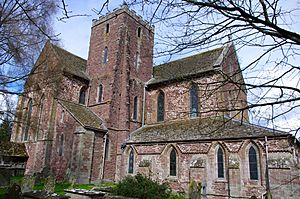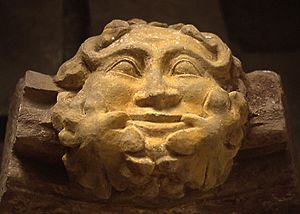Dore Abbey facts for kids
Quick facts for kids Dore Abbey |
|
|---|---|
| Church of the Holy Trinity & St Mary, Abbey Dore |
|

Dore Abbey
|
|
| Location | Abbey Dore, Herefordshire |
| Country | England |
| Denomination | Church of England |
| Website | http://www.achurchnearyou.com/abbeydore-holy-trinity-st-mary/ |
| Architecture | |
| Years built | 1147 onwards |
| Administration | |
| Parish | Abbey Dore |
| Diocese | Hereford |
Dore Abbey is a very old church in a village called Abbey Dore in Herefordshire, England. It used to be a large Cistercian monastery, which is a special place where monks lived and prayed. Today, a big part of the original building from the Middle Ages is still used as the local parish church. Other parts of the abbey are now ruined or have disappeared.
Contents
History of Dore Abbey
The abbey was started in 1147 by a powerful lord named Robert fitzHarold. He was the Marcher lord (a ruler of lands near the border of England and Wales) of Ewyas Harold. The abbey is built near the River Dore. It was set up as a "daughter house" of a Cistercian abbey in France called Morimond. This might have happened after Lord Robert met the Abbot of Morimond during the Second Crusade (a religious war).
Building work using local sandstone began around 1175. It continued while the first three abbots (leaders of the monastery) were in charge. The church's design was like Morimond's. It had a presbytery (the area around the altar), two chapels, two transepts (parts that stick out like arms of a cross), a crossing, and a nave (the main part of the church).
Growing Wealth and New Buildings
An old writer named Gerald of Wales said that the first Abbot Adam was very clever at getting land. In the early 1200s, the abbey got much more land. King John gave them good farmland in 1216. This helped the abbey become very rich, especially by selling wool.
Because it was so wealthy, the abbey was mostly rebuilt in the Early English style. The presbytery was made bigger. New chapels, a processional ambulatory (a walkway), and other buildings like a chapter house (where monks met) were added. In 1260, people called the abbey a "sumptuous church," meaning it was grand and impressive.
The new building was officially opened in 1282 by Thomas de Cantilupe, who was the Bishop of Hereford. It was dedicated to the Holy Trinity and Saint Mary. Around 1305, Richard Straddell became Abbot. He was a smart scholar and sometimes worked as a diplomat for the king. In 1321, he received a relic (a holy object) of the True Cross. After this, Dore Abbey became a place where people would go on a pilgrimage (a special religious journey).

Many parts of the 12th and 13th-century buildings are still there today. These include the north and south transepts and the tall columns inside. You can also see some old tiles, wooden fittings, and pieces of stained glass. The church also has two stone statues from the 13th century. People think they are of a later Lord Robert of Ewyas and his half-brother Roger de Clifford. There are also carved stone roof bosses (decorative carvings), including a famous Green Man.
How the Abbey Was Run
The abbey managed its lands with the help of seventeen "granges". These were like farms or estates run by the monks. Nine were in the Golden Valley. Four were in northern Gwent, and three were far to the west in Brycheiniog. These last ones were about a day's journey from the abbey. The abbey also owned property in Hereford and other places. It also earned money from five parishes (church areas) that it controlled.
The Abbey's Later Years and Restoration
The abbey was closed down in 1536 during the Dissolution of the Monasteries. This was when King Henry VIII closed many monasteries in England. A local landowner named John Scudamore bought the building. He came from a family linked to Owain Glyndŵr, a Welsh leader. Some valuable items were hidden, but most of the building was left to fall apart.
The remaining building was restored in the 1630s by John Scudamore's great-great-grandson, also named John Scudamore, 1st Viscount Scudamore. He felt he needed to make up for his family living off land that used to belong to the church. Scudamore was friends with William Laud, who was the Archbishop of Canterbury. It is thought that Laud helped with the new design and rebuilding of the church to be used as a parish church.
The original medieval altar was found on a nearby farm. It was being used to salt meat and make cheese! It was brought back to the church. The original nave was blocked off, and a new tower was built. A new carved oak rood screen (a screen separating the nave from the chancel) was made by John Abel. It included the coats of arms of Scudamore, Laud, and King Charles I. New stained glass was also added. The walls were painted with pictures and religious texts, and many of these can still be seen. The new church was officially opened again on March 22, 1634. More restoration work happened between 1700 and 1710. New paintings were added, including a large coat of arms of Queen Anne.
By the late 1800s, the church needed repairs again. A local architect named Roland Paul carried out work from 1901 to 1909. Paul also dug up and mapped the remaining foundations of the original abbey buildings, which are now under the churchyard.
Churchyard
The churchyard has the grave of Driver William John Watkins. He was a soldier in the Royal Field Artillery during World War I.
Other Burials
- Roger de Clifford (1189-1232)
- Sibil d'Ewyas Clifford, his wife (1178-1236)
- Roger de Clifford, their son (1215-86)

